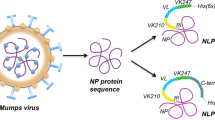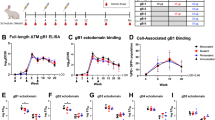Abstract
One potential benefit of DNA vaccines is the capacity to elicit antibody and T-cell responses against multiple antigens at the same time by mixing plasmids expressing different proteins. A possible negative effect of such mixing is interference among plasmids regarding immunogenicity. In preparation for a clinical trial, we assessed the immunogenicity of GMP-produced plasmids encoding five Plasmodium falciparum proteins, PfCSP, PfSSP2, PfEXP1, PfLSA1, and PfLSA3, given as a mixture, or alone. The mixture induced higher levels of antibodies against whole parasites than did the individual plasmids, but was associated with a decrease in antibodies to individual P. falciparum proteins. T-cell responses were in general decreased by administration of the mixture. Immune responses to individual plasmids and mixtures were generally higher in inbred mice than in outbreds. In inbred BALB/c and C57BL/6 mice, coadministration of a plasmid expressing murine granulocyte–macrophage colony-stimulating factor (mGM-CSF), increased antibody and T-cell responses, but in outbred CD-1 mice, coadministration of mGM-CSF was associated with a decrease in antibody responses. Such variability in data from studies in different strains of mice underscores the importance of genetic background on immune response and carefully considering the goals of any preclinical studies of vaccine mixtures planned for human trials.
This is a preview of subscription content, access via your institution
Access options
Subscribe to this journal
Receive 6 digital issues and online access to articles
$119.00 per year
only $19.83 per issue
Buy this article
- Purchase on Springer Link
- Instant access to full article PDF
Prices may be subject to local taxes which are calculated during checkout

Similar content being viewed by others
References
Hoffman SL, Franke ED, Hollingdale MR, Druilhe P . Attacking the infected hepatocyte. In: Hoffman SL (ed). Malaria Vaccine Development: A Multi-Immune Response Approach. ASM Press: Washington, DC, 1996, pp 35–75.
Sedegah M, Hedstrom R, Hobart P, Hoffman SL . Protection against malaria by immunization with plasmid DNA encoding circumsporozoite protein. Proc Natl Acad Sci USA 1994; 91: 9866–9870.
Doolan DL, Sedegah M, Hedstrom RC, Hobart P, Charoenvit Y, Hoffman SL . Circumventing genetic restriction of protection against malaria with multi-gene DNA immunization: CD8+ T cell, interferon-gamma, and nitric oxide dependent immunity. J Exp Med 1996; 183: 1739–1746.
Hedstrom RC, Doolan DL, Wang R et al. In vitro expression and in vivo immunogenicity of Plasmodium falciparum pre-erythrocytic stage DNA vaccines. Int J Mol Med 1998; 2: 29–38.
Aguiar JC, Hedstrom RC, Rogers WO et al. Enhancement of the immune response in rabbits to a malaria DNA vaccine by immunization with a needle-free jet device. Vaccine 2001; 20: 275–280.
Jones TR, Narum DL, Gozalo AS et al. Protection of Aotus monkeys by Plasmodium falciparum EBA-175 prime-protein boost immunization regimen. J Infect Dis 2001; 183: 303–312.
Jones TR, Gramzinski RA, Aguiar JC et al. Absence of antigenic competition in Aotus monkeys immunized with Plasmodium falciparum DNA vaccines delivered as a mixture. Vaccine 2002; 20: 1675–1680.
Rogers WO, Baird JK, Kumar A et al. Multistage multiantigen heterologous prime boost vaccine for Plasmodium knowlesi malaria provides partial protection in rhesus macaques. Infect Immun 2001; 69: 5565–5572.
Wang R, Doolan DL, Charoenvit Y et al. Simultaneous induction of multiple antigen-specific cytotoxic T lymphocytes in nonhuman primates by immunization with a mixture of four Plasmodium falciparum DNA plasmids. Infect Immun 1998; 66: 4193–4202.
Wang R, Doolan DL, Le TP et al. Induction of antigen-specific cytotoxic T lymphocytes in humans by a malaria DNA vaccine. Science 1998; 282: 476–480.
Le TP, Coonan KM, Hedstrom RC et al. Safety, tolerability and humoral immune responses after intramuscular administration of a malaria DNA vaccine to healthy adult volunteers. Vaccine 2000; 18: 1893–1901.
Wang R, Epstein J, Baraceros FM et al. Induction of CD4(+) T cell-dependent CD8(+) type 1 responses in humans by a malaria DNA vaccine. Proc Natl Acad Sci USA 2001; 98: 10817–10822.
Weiss WR, Ishii KJ, Hedstrom RC et al. A plasmid encoding murine granulocyte–macrophage colony-stimulating factor increases protection conferred by a malaria DNA vaccine. J Immunol 1998; 161: 2325–2332.
Sedegah M, Weiss W, Sacci Jr JB et al. Improving protective immunity induced by DNA-based immunization: priming with antigen and GM-CSF encoding plasmid DNA and boosting with antigen expressing recombinant poxvirus. J Immunol 2000; 164: 5905–5912.
Kumar S, Epstein JE, Richie TL et al. A multilateral effort to develop DNA vaccines against falciparum malaria. Trends Parasitol 2002; 18: 129–135.
Hoffman SL, Doolan DL . Malaria vaccines-targeting infected hepatocytes. Nat Med 2000; 6: 1218–1219.
Malik A, Egan JE, Houghten RA, Sadoff JC, Hoffman SL . Human cytotoxic T lymphocytes against the Plasmodium falciparum circumsporozoite protein. Proc Natl Acad Sci USA 1991; 88: 3300–3304.
Sedegah M, Sim BKL, Mason C et al. Naturally acquired CD8+ cytotoxic T lymphocytes against the Plasmodium falciparum circumsporozoite protein. J Immunol 1992; 149: 966–971.
Weiss WR, Berzovsky JA, Houghten RA, Sedegah M, Hollingdale M, Hoffman SL . A T cell clone directed at the circumsporozoite protein which protects mice against both Plasmodium yoelii and Plasmodium berghei. J Immunol 1992; 149: 2103–2109.
Doolan DL, Hoffman SL . The complexity of protective immunity against liver-stage malaria. J Immunol 2000; 165: 1453–1462.
Perlaza BL, Sauzet JP, Balde AT et al. Long synthetic peptides encompassing the Plasmodium falciparum LSA3 are the target of human B and T cells and are potent inducers of B helper, T helper and cytolytic T cell responses in mice. Eur J Immunol 2001; 31: 2200–2209.
Meraldi V, Nebie I, Moret R et al. Recognition of synthetic polypeptides corresponding to the N- and C-terminal fragments of Plasmodium falciparum Exp-1 by T-cells and plasma from human donors from African endemic areas. Parasite Immunol 2002; 24: 141–150.
Sedegah M, Charoenvit Y, Minh L et al. Reduced immunogenicity of DNA vaccine plasmids in mixtures. Gene Therapy 2004; 11: 448–456.
Kumar S, Villinger F, Oakley M et al. A DNA vaccine encoding the 42 kDa C-terminus of merozoite surface protein 1 of Plasmodium falciparum induces antibody, interferon-gamma and cytotoxic T cell responses in rhesus monkeys: immuno-stimulatory effects of granulocyte macrophage-colony stimulating factor. Immunol Lett 2002; 81: 13–24.
Kolodny N, Kitov S, Vassell MA et al. Two-step chromatographic purification of recombinant Plasmodium falciparum circumsporozoite protein from Escherichia coli. J Chromatogr B 2001; 762: 77–86.
Daubersies P, Thomas AW, Millet P et al. Protection against Plasmodium falciparum malaria in chimpanzees by immunization with the conserved pre-erythrocytic liver-stage antigen 3. Nat Med 2000; 6: 1258–1263.
Caspers P, Etlinger H, Matile H, Pink JR, Stuber D, Takacs B . A Plasmodium falciparum malaria vaccine candidate which contains epitopes from the circumsporozoite protein and a blood stage antigen, 5.1. Mol Biochem Parasitol 1991; 47: 143–150.
Charoenvit Y, Mellouk S, Cole C et al. Monoclonal, but not polyclonal antibodies protect against Plasmodium yoeli sporozoites. J Immunol 1991; 146: 1020–1025.
Blum Tirouvanziam U, Servis C, Habluetzel A et al. Localization of HLA-A2.1-restricted T cell epitopes in the circumsporozoite protein of Plasmodium falciparum. J Immunol 1995; 154: 3922–3931.
Wizel B, Rogers WO, Houghten RA, Lanar DE, Tine JA, Hoffman SL . Induction of murine cytotoxic T lymphocytes against Plasmodium falciparum sporozoite surface protein 2. Eur J Immunol 1994; 24: 1487–1495.
Miyahira Y, Murata K, Rodriguez D et al. Quantification of antigen specific CD8+ T cells using an ELISPOT assay. J Immunol Methods 1995; 181: 45–54.
Sedegah M, Jones TR, Kaur M et al. Boosting with recombinant vaccinia increases immunogenicity and protective efficacy of malaria DNA vaccine. Proc Natl Acad Sci USA 1998; 95: 7648–7653.
Acknowledgements
We are grateful to Romeo Wallace, Victoria Fallame Majam, and Harini Ganeshan for technical support. We thank Dr WR Weiss for discussions and editorial assistance. The experiments reported here were carried out according to the principles set forth in the ‘Guide for the Care and Use of Laboratory Animals’, Institute of Laboratory Animals Resources, National Research Council, National Academy Press, 1996. This study was supported by Naval Medical Research Center work unit #A2284. The opinions and assertions herein are the private ones of the authors and are not to be construed as official or as reflecting the views of the US Navy, the US Department of Defense, or the US Government.
Author information
Authors and Affiliations
Corresponding author
Rights and permissions
About this article
Cite this article
Sedegah, M., Charoenvit, Y., Aguiar, J. et al. Effect on antibody and T-cell responses of mixing five GMP-produced DNA plasmids and administration with plasmid expressing GM-CSF. Genes Immun 5, 553–561 (2004). https://doi.org/10.1038/sj.gene.6364125
Received:
Revised:
Accepted:
Published:
Issue Date:
DOI: https://doi.org/10.1038/sj.gene.6364125
Keywords
This article is cited by
-
Novel Plasmodium antigens identified via genome-based antibody screen induce protection associated with polyfunctional T cell responses
Scientific Reports (2017)
-
Immunogenicity of a chimeric Plasmodium falciparum merozoite surface protein vaccine in Aotus monkeys
Malaria Journal (2016)
-
Identification of two new protective pre-erythrocytic malaria vaccine antigen candidates
Malaria Journal (2011)
-
Genetic vaccination approaches against malaria based on the circumsporozoite protein
Wiener klinische Wochenschrift (2006)



